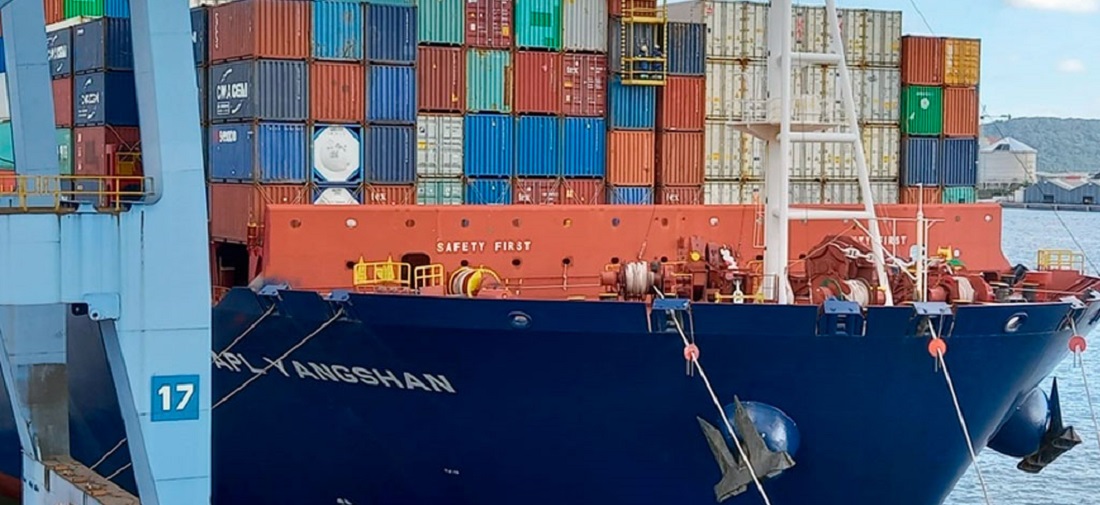
Mega containerships pose challenge to ferry crossings at the Port of Santos
Nov, 10, 2022 Posted by Gabriel MalheirosWeek 202245
The ferry crossing system between Santos and Guarujá, on the south coast of São Paulo, is chaotic as it is. The mega containership APL Yangshan, 347 meters long and 45.2 meters wide, which left the Port of Santos on Nov 09, brought up even more worrying factors.
Specialists and the Santos Port Authority predict that more vessels as big as this, or even larger, will stop at the port more frequently in the coming months. Ships passing through Santos are typically 225 meters long.
In October, the Maltese-flagged vessel CMA CGM Vela, also measuring 347 meters, halted port activities for almost three hours and mobilized six tugboats to dock on the port’s left bank – on the Guarujá side.
The activity halt caused by the Singapore-flagged ship on Tuesday (8) occurred between 1:30 and 3 p.m., as determined by the Port Authority and the Brazilian Navy following Ordinance 74/2021. The activities stopped on Wednesday (9) from 1:30 to 2:30 p.m.
“[The arrival of these ships] had long been envisaged, and the port has prepared for it, even though the pandemic caused these plans to be postponed a little. Although we cannot pinpoint the frequency, we know that these operations will grow more common depending on the global flow of trade,” stated Bruno Stupello, SPA’s Business Development Director.
“These mega containerships are common in the northern hemisphere, but they are coming southward as well. It is a market trend that shipowners start to adopt not only on east-west services between Asia and the USA but also on north-south routes,” he said.
In consonance with this thesis, at the beginning of the month, the port of Rio Grande, in southern Brazil, received the Asian freighter One Amazon, 330 meters long, which left Busan, South Korea.
According to the latest development and zoning plan for the port of Santos, cargo throughput is expected to increase by almost 50% over the next 20 years by adding over 67.9 million tonnes, jumping to 214.9 million tonnes of total demand.
The trend is that the arrival of larger vessels will cause less impact on operations over time — except for the ferry system that transports vehicles between the two neighboring coastal cities.
The passage of these vessels prevents users from waiting with the vehicles positioned inside the ferries due to the risk of waves caused by the maneuvers. It is common to see ferries waiting for 15 minutes in response to the passage of smaller ships.
On Tuesday and Wednesday, however, the waiting time was 1 hour and 30 minutes and 1 hour, respectively. The users of the crossing service were instructed by the City Hall of Santos and the Department of Logistics and Transport to make the journey by land.
“Ferry users will always be penalized in situations like this. As we know, the tendency is for things like that to become more common. There is no alternative ferry route, hence the importance of urgently building some dry connection between the cities,” said the Secretary of Logistics and Transport of the State of São Paulo, João Octaviano Machado.
According to the Waterway Department, the crossing operation between the municipalities employs five ferries on average — the maximum quantity allowed is 7, with one in reserve.
“If new mega vessels appear, it will be pointless to mobilize seven ferries. We will have to stop them anyway,” said the secretary.
According to ministry data, 28,999 tickets were sold in September to cross between Santos and Guarujá in September was 28,999 tickets. The figure includes 13,554 four-wheeled vehicles and 8,234 motorcycles, as well as 7,034 cyclists and 177 pedestrians.
The alternatives to this situation are still far from getting off the ground. In recent years, the dry connection between Santos and Guarujá has been stalled due to the controversy over which would be the best solution: a bridge, favored by the state government, or an underwater tunnel, selected by the port authority, by the federal government and by the “Vou de Túnel” movement, led by a group of naval engineers, companies, and associations.
“We have always defended that bridges and tunnels are not mutually exclusive. We need the bridge connecting the right bank to the left and the tunnel for urban mobility,” stated Secretary Octaviano.
“Today, the process for selecting the best alternative is on pause due to the change in government. The controversy between a bridge or tunnel is something overdue. We will need a new legal and regulatory model, a new project to get it off the ground,” said Casemiro Tércio, former president of SPA and one of the mentors of “Vou de Túnel.”
The last alternative cited by the state government is accelerating the feasibility of the green line (a new highway to the port), announced in March 2021, as a route that would alleviate the Anchieta-Imigrantes highway system, with the creation of new logistics alternatives between Santos and São Paulo.
In September, the Waterway Department began operating another ferry, with a capacity for 50 vehicles in addition to 150 passengers, which was renovated with a R$ 4.5 million investment.
Days before the new ferry, residents of both cities had to wait for hours due to the slow crossing, compromised by adverse weather conditions, according to the department.
For the beginning of the summer season, movement is likely to increase by up to 40%.
Source: Folha de S. Paulo
To read the full original article, please go to: https://www1.folha.uol.com.br/mercado/2022/11/meganavios-no-porto-de-santos-podem-piorar-caos-em-travessia-de-balsas.shtml
-
Ports and Terminals
Nov, 18, 2024
0
Port of Santos Railway Operator Expands Investments, Accelerates Billion-Dollar Infrastructure Overhaul
-
Portos e Terminais
Feb, 25, 2022
0
The port of Arroio do Sal received its first environmental permit
-
Economy
Oct, 17, 2024
0
Argentina’s trade surplus nears $16 billion under Milei
-
Ports and Terminals
Jul, 16, 2020
0
Ministry of Infrastructure signs addendum to expand Port of Imetame (ES)

